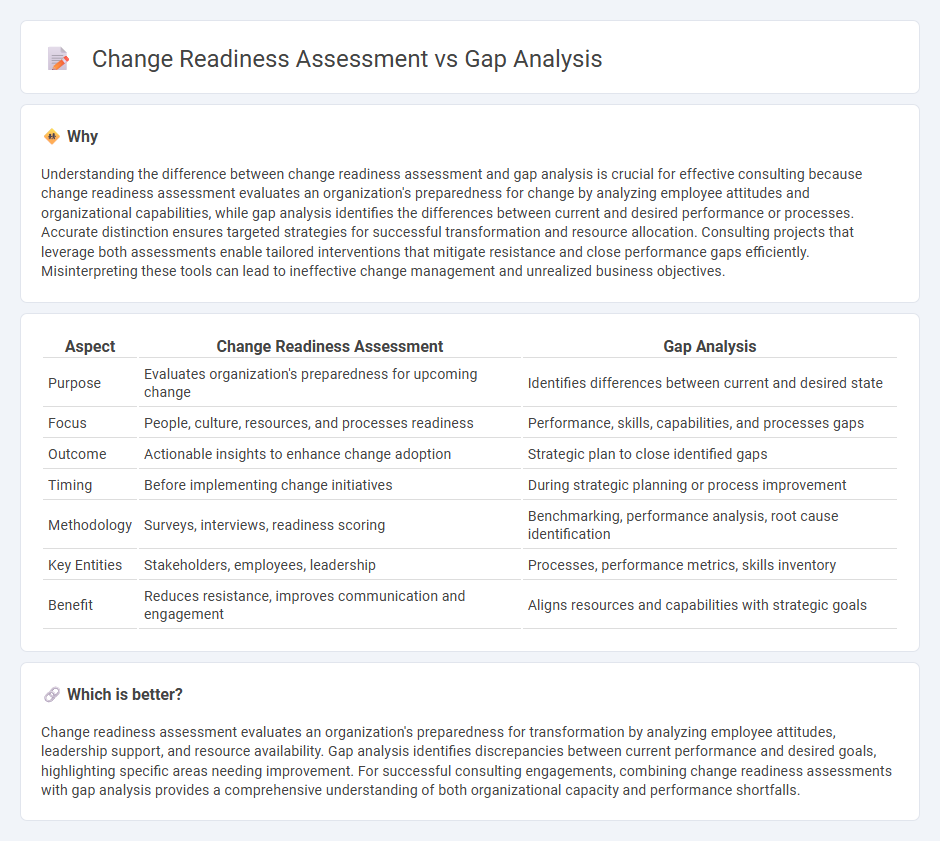
Change readiness assessment evaluates an organization's preparedness for upcoming transformations by measuring employee mindset, resource availability, and leadership support. Gap analysis identifies discrepancies between current performance and desired outcomes, pinpointing specific areas for improvement to bridge these gaps effectively. Explore how both tools complement each other in driving successful organizational change.
Why it is important
Understanding the difference between change readiness assessment and gap analysis is crucial for effective consulting because change readiness assessment evaluates an organization's preparedness for change by analyzing employee attitudes and organizational capabilities, while gap analysis identifies the differences between current and desired performance or processes. Accurate distinction ensures targeted strategies for successful transformation and resource allocation. Consulting projects that leverage both assessments enable tailored interventions that mitigate resistance and close performance gaps efficiently. Misinterpreting these tools can lead to ineffective change management and unrealized business objectives.
Comparison Table
| Aspect | Change Readiness Assessment | Gap Analysis |
|---|---|---|
| Purpose | Evaluates organization's preparedness for upcoming change | Identifies differences between current and desired state |
| Focus | People, culture, resources, and processes readiness | Performance, skills, capabilities, and processes gaps |
| Outcome | Actionable insights to enhance change adoption | Strategic plan to close identified gaps |
| Timing | Before implementing change initiatives | During strategic planning or process improvement |
| Methodology | Surveys, interviews, readiness scoring | Benchmarking, performance analysis, root cause identification |
| Key Entities | Stakeholders, employees, leadership | Processes, performance metrics, skills inventory |
| Benefit | Reduces resistance, improves communication and engagement | Aligns resources and capabilities with strategic goals |
Which is better?
Change readiness assessment evaluates an organization's preparedness for transformation by analyzing employee attitudes, leadership support, and resource availability. Gap analysis identifies discrepancies between current performance and desired goals, highlighting specific areas needing improvement. For successful consulting engagements, combining change readiness assessments with gap analysis provides a comprehensive understanding of both organizational capacity and performance shortfalls.
Connection
Change readiness assessment evaluates an organization's preparedness for transformation by analyzing workforce skills, leadership alignment, and resource availability. Gap analysis identifies specific discrepancies between current capabilities and desired future states, highlighting areas needing improvement. Together, these methodologies enable consultants to tailor change management strategies that address organizational weaknesses and accelerate successful implementation.
Key Terms
Current State vs. Desired State
Gap analysis identifies discrepancies between the current state and desired state by evaluating existing processes, resources, and performance metrics to pinpoint specific areas needing improvement. Change readiness assessment evaluates an organization's preparedness for transition by measuring employee engagement, resource availability, and potential barriers to successful implementation. Explore deeper insights to optimize your strategic planning and change management processes.
Capability Gaps
Gap analysis identifies specific capability gaps by comparing current skills and resources against desired business objectives. Change readiness assessment evaluates the organization's preparedness, including employee willingness and capacity to adopt new capabilities. Explore detailed strategies to bridge capability gaps and enhance change readiness for successful transformation.
Organizational Culture
Gap analysis identifies discrepancies between current organizational culture and desired future states by measuring existing values, behaviors, and norms against strategic objectives. Change readiness assessment evaluates employees' willingness, motivation, and capacity to adapt cultural shifts, emphasizing engagement levels and potential resistance. Discover how aligning these approaches enhances cultural transformation initiatives effectively.
Source and External Links
What is gap analysis and how does it work? - TechTarget - Gap analysis is a method for assessing whether business requirements or objectives are being met by comparing the current processes and performance against target goals to develop a plan for improvement.
How Gap Analysis Can Drive Strategic Change in Your Organization - Gap analysis involves defining the current and desired business states, identifying performance or opportunity gaps, and addressing misalignments in purpose, strategy, or objectives to enable organizational change.
Gap analysis - Wikipedia - Gap analysis is a formal study comparing actual business performance with desired performance to reveal areas for improvement in resources, processes, or strategies across organizational levels.
 dowidth.com
dowidth.com